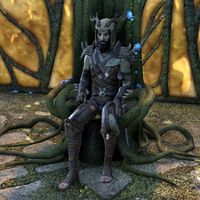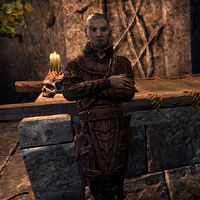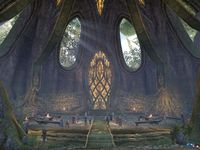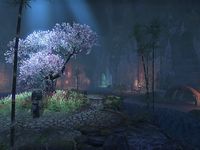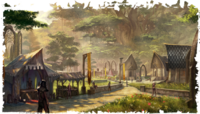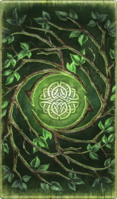Lore:Elden Root
| Elden Root | |
|---|---|
| Type | Settlement |
| Continent | Tamriel |
| Province | Valenwood |
| Region | Grahtwood (Green Hall) |
| Appears in | Arena, ESO |

Elden Root (also spelled Eldenroot)[1][2] is one of the eight major cities in the province of Valenwood,[3] situated in the southern heart of the Bosmer's great forests, Grahtwood.[4] Not only is Elden Root the self-proclaimed "center of the Wood Elven nation",[2] but it is also one of Valenwood's six major countries.[5] It is a vast hub of trade and commerce, where many wealthy merchants and officials retain large-scale operations.[1] At the center of it all is one of the legendary Elden Trees, the titanic subspecies of the already enormous graht-oak trees that laden the southeast.[4][6]
Contents
Layout & Geography[edit]
The Elden Tree is one of the migratory graht-oak trees of Valenwood,[6] but it has rooted itself in central Grahtwood, next to a large lake east of it. Most of the city itself is set throughout the branches and canopies of the Elden Tree, but there is also an outer district that runs along the eastern base of the tree, through the hills and the lake. The roots of the graht-oak run over the outer streets and even borough underneath the earth, but with the help of the local greenspeakers, they also form long, wiry bridges over the lake and streets. They also create graht-oak tree pods, the typical one-room home of the Bosmer.[7] The Ayleid ruins that dot the landscape are spread out and completely inaccessible. A blocked entrance can be found on the island southeast of the tree, on the main road that runs through the city.[8]
The terrain underneath the Elden Tree has been used for a several purposes, but more often than not as extra living space. The old Ayleid Ruins of Elden Hollow were once used by noble Ayleid clans as a living quarter before it was converted into a cemetery for centaurs and minotaurs.[9][10] There is a cave system directly underneath the Elden Tree called the Middens, where the lowlife and malcontent conduct their business or hide away from the law.[8][11] Elden Root is neighbored by several settlements, including Archen Cormount to the south-southwest, Lynpar March to the east, Meadow Run to the west, Moonmont to the north, and Wasten Brukbrook to the southeast.[3]
The first floor of the tree is a vast and hollowed-out hall, centered around the local wayshrine. Many merchants and artisans set their shops in the southern end of the hall and the hill toward the tree, while the people tend to gather and converse in the middle. The north end has a small pond and meditation spot where the local spinners are located and tell stories to anyone interested.[12] The west end is the hallway that ascends higher up the tree, to the second floor, the city's great marketplace known as the Great Trunk Artisans Court. This area is adorned with vines and garlands with either glowing blue or yellow flowers, and at the center of it all is a quaint blue tree. The area is also paved and assorted with stones, from the floor, to the sturdy stone wall that holds the incline to the Throne Room, and the stone circles and menhirs that decorate the area. [8]
Notable Locales[edit]
|
|
History[edit]
Early History[edit]
The Elden Tree that served as the basis of the settlement is one of the many graht-oaks trees known collectively as the Green-Sap, which grew from the Perchance Acorn.[13] The settlement was initially occupied by an ancient tribe of Wood Elves ruled by the Treethane, that lived independent from the other tribes until King Eplear founded the Camoran Dynasty in 1E 0 and annexed every tribe under his newfound Empire.[5] Much like other settlements based in the graht-oak trees, Elden Root migrated throughout the forest once every season and with the Ayleid Diaspora in 1E 243, saw the arrival of Ayleid refugees from Cyrodiil.[13]
Among the travelers that came to Elden Root was King Anumaril of Abagarlas, who carried a segment of his Staff of Towers as a femur. Anumaril sought to re-create the Ayleid Empire and the majesty of the White-Gold Tower with the Green-Sap of Elden Root. But despite his agreement to not disturb the Green, he met with the Great Camoran, who showed him the Perchance Acorn. He placed the segment in the roots and created the Definite Acorn, which in turn rooted Elden Root in central Grahtwood. His last known creation was the Orrery of Elden Root, where he placed the segment-scepter between the moons. However, because of Anumaril's lack of understanding Bosmeri magic, nothing happened and his plans failed. But as the historian, Beredalmo the Signifier puts it in the mid-Second Era, "The Ayleid fangler's plan could not succeed—and yet neither could it fail. For this is a story that has not yet found its ending."[13]
The Ayleids that lived in Elden Root expanded on the Elden Tree and built universities and libraries.[14] Some of the more important Ayleid clans were given the right to excavate underneath the Elden Tree and build dwelling halls. That section later became known as Elden Hollow,[9] and it was later used as a large tomb for generations of centaurs and minotaurs before it was abandoned.[10] All of Valenwood continued underneath the Camoran reign for many years until the province's defeat against the Second Empire in 1E 2714. As a contingency plan for a possible uprising, the Empire granted independence to each of the province's treethanes, so that they may never unite against a common foe. Elden Root was among five other countries that turned from a local trading post into a fully-fledged political power in its own right.[5] Elden Root was named the capital of what was then called, the Kingdom of Grahtwood.[4] The known scope of the kingdom ranged from the town of Cormount,[15] all the way to the Long Coast. The outer reaches of the geographical region like Reman's Bluff were beyond it's borders.[16]
The Camoran Dynasty and Elden Root[edit]
With the dissolution of the Second Empire in 2E 431, the Camoran Dynasty tried once again to reinstate their power, but because of how culturally divided the other nations were, the possibility of unification was not foreseeable. Because of this, each of the different treethane kingdoms waged war with each other and saw invasions coming from their neighbors such as the Colovians and the Khajiit.[5] After they sacked both Haven and Woodhearth on the coast, the Maormer marched inland and besieged not only Elden Root, but the Elden Tree itself.[14] When the Elden Tree of Falinesti vanished without a trace, it left Elden Root as the seat of the Camoran Dynasty. The Mages Guild scholar, Andewen dates the city's disappearance roughly around 2E 382 and 432.[17]
By the fifth century, the city was ruled by King Aeradan Camoran. His ascension to the throne was contested by his cousin, Camoran Gelthior of Cormount. The King sought to "renew" the land and the philosophy of the Bosmer people, however, Gelthior believed that the people deserved a ruler that understands the ancient compacts of the Green Pact. A civil war broke out between Aeradan's loyalist and the Blacksap Movement in 2E 489.[15][18] The war lasted for roughly a century[19] and in its latter-half saw the involvement of the Colovians, who were in favor of the Blacksap.[20] Aeradan was facing a losing battle and decided to call for support from Queen Ayrenn in 2E 580. Their combined forces were able to crush the Blacksap and send them back into Cormount.[19]
With their newfound friendship, both parties had created the First Aldmeri Dominion,[19] along with the Khajiit of Elsweyr. King Aeradan and Queen Ayrenn, along with the Speaker of the Mane, Gharesh-ri signed the Elden Accord, which solidified their alliance. The Dominion proclaimed Elden Root as their capital,[21][22] and built the Altmer Embassy for citizens of the alliance, with the promise of a Khajiit Embassy in 2E 581.[23] Prince Naemon was placed in Elden Root as Queen Ayrenn's representative in the court, if she was ever away.[24]
Elden Root in the Aldmeri Dominion[edit]
After a year, the Khajiit Embassy was never built and it caused a stir among the people in Elden Root.[23] The project was headed by Ambassador Tarinwe of the Altmer Embassy, and Prince Naemon sent an Agent of the Dominion to investigate the situation. The ambassador claimed that supplies were ready for the Khajiit, but upon a closer look, the supplies were practically useless, much to the confusion of the Prince. The Agent traveled to the nearby ruins, where stonemasons were supposed to acquire materials, but discovered dead bodies laden across the mire. The King was also suspicious of the Ambassador, and sent one of the Vinedusk Rangers, Azareth to investigate. The two uncovered a conspiracy against the Dominion and that Tarinwe made an attempt to escape via the Middens underneath the Elden Tree. She was captured and put on trial for her actions.[25]
Not long after the situation, Queen Ayrenn traveled to Elden Root to begin the ratification ceremony, which would divine her capacity to rule as Empress. But in order to go forward with the process, the ceremony needed three items of importance, a "divine spark," an Ayleid source of power, and a skilled operator. The Agent traveled to separate corners of the region, to the west, they traveled to the Falinesti Winter Site, where they acquired the "divine spark," Rajhin's Mantle. To the northeast, they traveled to the Reliquary of Stars, where they would locate the Heart of Anumaril, which originally brought life to the Orrery. Finally, they traveled to the southwest, to the town of Southpoint, where the Conservator, Daraneth was located.[26] With every component in hand, the ratification ceremony started as scheduled, but before the Queen would enter the Orrery, Naemon entered first and was transformed into an Ogrim. He was slain by the Agent and despite the death of her brother, Ayrenn continued with the ceremony and received a vision of the Imperial City and Tamriel, at peace under the Aldmeri Dominion.[27] Ayrenn's rule had solidified further, but when the Staff of Magnus was stolen from Marbruk, she sent the Agent to locate it.[28]
In the latter years of the Interregnum, the tribes of Valenwood were once again divided and left to their own devices. But the arrival of the Second Aldmeri Dominion saw the unification of the province again.[5] Because of the moving nature of Falinesti, the Thalmor decided to move the capital of the province to Elden Root.[29]
Elden Root in the Third Empire[edit]
During the Imperial Simulacrum in the late Third Era, the city-state of Eldenroot was an active settlement. It was ruled by Queen Ulandra and it had a rivalry with several cities (namely Greenheart, Silvenar, and Southpoint).[2] At around that time, the province saw radical changes that made it unsafe for travelers and after two months of investigation, Elden Root rangers were decapitated and their heads were presented to the Queen by an emissary of Selene, High Priestess of Shagrath. The Priestess gave the Queen an ultimatum, where if they did not surrender Valenwood, they would all die.[30] At that same time, the Eternal Champion had made their way toward Eldenroot after they acquired their second piece of the Staff of Chaos, in the hopes of obtain the third piece in the Elden Grove. The Champion made contact with the Queen, who offered the location's whereabouts, only if the warrior defeated Selene in her domain, Selene's Web and obtain her heart, a cloudy white, opaque diamond. After the threat had been vanquished, Queen Ulandra marked Elden Grove on their map, and the traveler continued with their quest.[31] Ever since the Champion's victory over Jagar Tharn, Imperial-loyalists would re-trace their steps across the provinces, and occasionally made their way through Eldenroot.[32]
Gallery[edit]
See Also[edit]
- For game-specific information, see the Arena and Elder Scrolls Online articles.
Books[edit]
- Aurbic Enigma 4: The Elden Tree Inscribed by Beredalmo the Signifier — The story of Green-Sap, the Tower of the Bosmer
- The Book of the Great Tree — Excerpts regarding the First Tree of the Elden Grove
- Elden Root Safety Precautions — Warnings to visitors of Elden Root
- Ode to the Elden Tree — A poem dedicated to the Orrery of Elden Root
Notes[edit]
- Root Liqueur is a rare delicacy created by the Wood Elves ages ago. It is blasphemous to make in the eyes of the Green Pact because it is made with wood clippings from Elden Root's Elden Tree. It is described as sweet and very syrupy.[33]
- Arena was originally conceived as a fighting game featuring a tournament that took the player to each of Tamriel's cities to challenge different gladiatorial teams. According to a file from that stage of development left behind in the final game, Elden Root's gladiatorial team would have been called "the Cavaliers".[UOL 1]
References[edit]
- ^ a b The Black Arrow, v 1 — Gorgic Guine
- ^ a b c Eldenroot location and rumors in Arena
- ^ a b Map of Valenwood – The Elder Scrolls: Arena
- ^ a b c Grahtwood loading screen text in ESO
- ^ a b c d e Pocket Guide to the Empire, 3rd Edition: The Wilds Remain: Valenwood — Imperial Geographical Society, 3E 432
- ^ a b Elden Root loading screen text in ESO
- ^ Snugpod loading screen text in ESO
- ^ a b c Elden Root location in ESO
- ^ a b Elden Hollow loading screen text in ESO
- ^ a b Dracien Montue's dialogue in ESO
- ^ Azareth's dialogue in ESO
- ^ Girnalin NPC in ESO
- ^ a b c Aurbic Enigma 4: The Elden Tree — Beredalmo the Signifier
- ^ a b Ayleid Cities of Valenwood — the Esteemed Historian Homfrey at the University of Gwylim, 2E 455
- ^ a b The Rise of Cormount
- ^ The Founding of Southpoint — the Provincial Office of Governor Zantonius
- ^ Andewen's dialogue in ESO
- ^ Gelthior's dialogue in ESO
- ^ a b c Ask Us Anything: Aldmeri Dominion (Part 1) – The Elder Scrolls Online Website
- ^ Ervalir's dialogue in ESO
- ^ Queen Ayrenn's dialogue in ESO
- ^ Ask Us Anything: Aldmeri Dominion (Part 2) – The Elder Scrolls Online Website
- ^ a b King Camoran Aeradan's dialogue in ESO
- ^ Prince Naemon's dialogue in ESO
- ^ The Honor of the Queen story quest in ESO
- ^ Fit to Rule story quest in ESO
- ^ The Orrery of Elden Root story quest in ESO
- ^ The Staff of Magnus story quest in ESO
- ^ Pocket Guide to the Empire, 1st Edition: Aldmeri Dominion — Imperial Geographical Society, 2E 864
- ^ Queen Ulandra's dialogue in Arena
- ^ Elden Grove story quest in Arena
- ^ A Minor Maze
- ^ Bregolin's dialogue in ESO: Clockwork City
Note: The following references are considered to be unofficial sources. They are included to round off this article and may not be authoritative or conclusive.
- ^ Original TES: Arena texts at The Imperial Library





